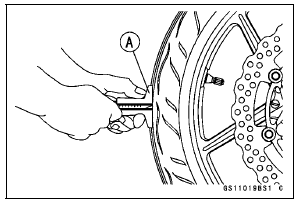

As the tire tread wears down, the tire becomes more susceptible to puncture and failure. An accepted estimate is that 90% of all tire failures occur during the last 10% of tread life (90% worn). So it is false economy and unsafe to use the tires until they are bald.
If any measurement is less than the service limit, replace the tire (see Tire Removal/Installation in the Wheels/Tires chapter).

Tread Depth Standard:
Front 3.6 mm (0.14 in.)
Rear 5.3 mm (0.21 in.)
Service Limit:
Front 1 mm (0.04 in.) (AT, CH, DE) 1.6 mm (0.06 in.)
Rear 2 mm (0.08 in.) (Up to 130 km/h (80 mph)) 3 mm (0.12 in.) (Over 130 km/h (80 mph))
| WARNING Some replacement tires may adversely affect handling and cause an accident resulting in serious injury or death. To ensure proper handling and stability, use only the recommended standard tires for replacement, inflated to the standard pressure. |
NOTE
 Wheel/Tire Damage Inspection
Wheel/Tire Damage Inspection Wheel Bearing Damage Inspection
Wheel Bearing Damage InspectionLower Fairing Removal
Remove the quick rivets [A].
Remove:
Quick Rivets [A]
Bolts [B]
Pull up the core by the flat-head screwdriver (–), and then
remove the quick rivet.
Clear the hook portions on the upper edges [C] from the
slots, and remove the left lower fairing [D].
While pulling down ...
Lower Fairing Installation
Installation is the reverse of removal. Note the following.
When installing the pad [A], align the edge of the pad and
the marking of the fairing [B].
When installing the pad [C], align the edge of the pad and
the fairing [D], and fit the edge of the pad to the boss [E].
Insert the hoo ...
Battery Removal
Turn off the ignition switch.
Remove the front seat (see Front Seat Removal in the
Frame chapter).
Slide the red cap [A].
Disconnect the negative (–) cable [B] and then positive
(+) cable [C].
NOTICE
Be sure to disconnect the negative (–) cable first.
Remove the band [D] ...